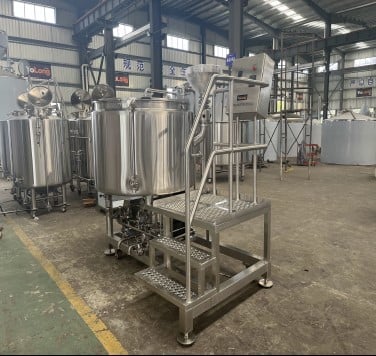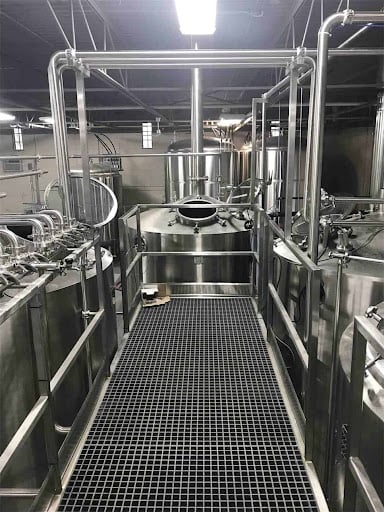Comprehensive Guide to Microbrewery Equipment
Microbreweries have surged in popularity as people’s love for craft beer has grown. Starting a microbrewery involves more than just a passion for brewing; it requires the right equipment. This guide delves into everything you need to know about microbrewery equipment, from the brewing process to choosing suppliers. Let’s explore the fascinating world of microbrewery equipment, ensuring you’re well-prepared to craft that perfect brew.
Overview of Microbrewery Equipment
When you think about starting a microbrewery, the image that comes to mind is often of large, gleaming tanks and the aroma of malt and hops. The reality involves understanding and investing in various equipment types tailored to the specific needs of your brewing process. This overview will touch on the essential components, their functions, and how they contribute to the overall brewing process.
Key Components of Microbrewery Equipment
- Malt Mill: Crushes the grains to release fermentable sugars.
- Mash Tun: Where the crushed grains are mixed with hot water to convert starches into sugars.
- Lauter Tun: Separates the wort (liquid) from the grain husks.
- Brew Kettle: Boils the wort with hops for flavor and stability.
- Whirlpool: Separates the hop particles from the wort post-boil.
- Fermentation Tanks: Where yeast is added to the wort to begin fermentation.
- Bright Beer Tanks: Holds beer post-fermentation for maturation and carbonation.
- Cooling System: Keeps the fermentation tanks at optimal temperatures.
- Cleaning Equipment: Ensures the sanitation of the brewing vessels.

Comprehensive Equipment Guide
Each piece of equipment in a microbrewery serves a crucial role in transforming raw ingredients into delicious craft beer. Here’s a detailed guide to what you’ll need:
Malt Mill
The malt mill is the first step in the brewing process. It grinds malted barley into grist, which allows water to extract sugars during mashing. Look for a mill that offers adjustable settings to control the grind size, ensuring consistent efficiency in your mash tun.
Mash Tun
The mash tun is a vessel where grist mixes with hot water to convert starches into fermentable sugars. Insulation and a heating system are critical to maintaining the right temperature during mashing. Some advanced tuns include agitators for better mixing and automated systems to manage temperature and time precisely.
Lauter Tun
Once mashing is complete, the lauter tun separates the liquid wort from the solid grain husks. It’s essential for ensuring clear wort and efficient extraction. Features to consider include an adjustable false bottom for better filtration and rakes to stir the grain bed, preventing clogging.
Brew Kettle
The brew kettle is where the wort is boiled and hops are added. A well-designed kettle will have a built-in heating system, often steam or electric, and a whirlpool feature to facilitate hop separation post-boil. The size of your brew kettle should match your intended batch sizes and allow for vigorous boiling without risking boil-overs.
Whirlpool
After boiling, the whirlpool tank helps separate hop particles and trub (sediment) from the wort. It’s crucial for achieving clear wort before fermentation. Look for a whirlpool with a tangential inlet, which promotes efficient separation.
Fermentation Tanks
Fermentation tanks are where the magic happens. Yeast is added to the wort, converting sugars into alcohol and CO2. These tanks should be temperature-controlled to maintain the ideal fermentation conditions. Conical fermenters are popular due to their ability to easily separate yeast and trub from the finished beer.
Bright Beer Tanks
Post-fermentation, beer is transferred to bright beer tanks for maturation, carbonation, and storage before packaging. These tanks should be pressure-rated and equipped with cooling jackets to keep the beer at the right temperature.
Cooling System
A reliable cooling system is essential for maintaining precise temperatures during fermentation and storage. Glycol chillers are common in microbreweries, providing consistent cooling power.
Cleaning Equipment
Maintaining cleanliness is paramount in brewing. Clean-In-Place (CIP) systems allow for automated cleaning of brewing vessels, ensuring thorough sanitation without disassembly.
Brewing Process Explained
Understanding the brewing process is crucial for selecting the right equipment. Here’s a detailed walkthrough:
Mashing
Mashing involves mixing crushed grains with hot water in the mash tun. The goal is to convert the starches in the grain into fermentable sugars. The temperature and duration of mashing can significantly affect the flavor and body of the beer.
Lautering
After mashing, the mixture is transferred to the lauter tun. Here, the liquid wort is separated from the grain husks. This process ensures a clear wort, which is crucial for the quality of the final beer.
Boiling
The wort is then boiled in the brew kettle. During this stage, hops are added at different times to impart bitterness, flavor, and aroma. Boiling also sterilizes the wort, eliminating unwanted microorganisms.
Whirlpooling
Post-boil, the wort is transferred to the whirlpool tank. The whirlpool action helps separate hop particles and trub from the wort, resulting in a clearer liquid ready for fermentation.
Fermentation
The clear wort is cooled and transferred to fermentation tanks, where yeast is added. The yeast ferments the sugars, producing alcohol and CO2. This process can take from a few days to several weeks, depending on the beer style.
Conditioning and Carbonation
Once fermentation is complete, the beer is transferred to bright beer tanks for conditioning and carbonation. This step allows the beer to mature and develop its final flavors. Carbonation can be achieved naturally through fermentation or by adding CO2.
Packaging
The final step is packaging the beer into bottles, cans, or kegs. Proper packaging equipment ensures the beer is filled, sealed, and labeled efficiently, preserving its quality until it reaches the consumer.
Equipment Types and Specifications
Here’s a detailed table of the various equipment types and their specifications to help you understand what you’ll need:
| Equipment | Description | Key Features |
|---|---|---|
| Malt Mill | Grinds malted barley into grist | Adjustable settings, consistent grind size |
| Mash Tun | Mixes grist with hot water to convert starches into sugars | Insulated, heating system, agitators |
| Lauter Tun | Separates liquid wort from grain husks | Adjustable false bottom, rakes |
| Brew Kettle | Boils wort with hops for flavor and stability | Built-in heating, whirlpool feature |
| Whirlpool | Separates hop particles from wort post-boil | Tangential inlet |
| Fermentation Tanks | Where yeast converts sugars into alcohol and CO2 | Temperature-controlled, conical shape |
| Bright Beer Tanks | Holds beer post-fermentation for maturation and carbonation | Pressure-rated, cooling jackets |
| Cooling System | Maintains precise temperatures during fermentation and storage | Glycol chillers |
| Cleaning Equipment | Automated cleaning of brewing vessels | CIP systems |
Brewing Capacity, Space, and Design Considerations
When planning a microbrewery, it’s essential to consider the brewing capacity, space requirements, and design layout. Here’s a detailed table to guide you:
| Aspect | Details |
|---|---|
| Brewing Capacity | Determine your production goals (e.g., barrels per week) to choose appropriately sized equipment. |
| Space Requirements | Plan for adequate space for all equipment, storage, and workflow efficiency. |
| Design Layout | Optimize layout for smooth operation, from milling to packaging, minimizing unnecessary movement. |
| Customization Options | Consider modular systems that allow for future expansion. |
Microbrewery Equipment Suppliers and Price Range
Selecting the right supplier is crucial. Here’s a table detailing some notable suppliers and their price ranges:
| Supplier | Equipment Range | Price Range |
|---|---|---|
| ABC Brew Co. | Full brewing systems, fermenters | $10,000 – $100,000 |
| BrewTech Solutions | Customizable brewing equipment | $15,000 – $120,000 |
| CraftBrew Engineers | Turnkey brewing systems | $20,000 – $150,000 |
| FermentMaster Inc. | Fermentation tanks, bright beer tanks | $5,000 – $50,000 |
Installation, Operation, and Maintenance
Proper installation, operation, and maintenance are key to a successful brewing operation. Here’s what you need to know:
| Aspect | Details |
|---|---|
| Installation | Professional installation ensures equipment is set up correctly, reducing future issues. |
| Operation | Training for staff on operating equipment safely and efficiently is crucial. |
| Maintenance | Regular maintenance schedules prevent breakdowns and prolong equipment life. |
Choosing the Right Supplier
Here’s how to choose the best supplier for your microbrewery equipment:
| Criteria | Details |
|---|---|
| Reputation | Look for suppliers with positive reviews and a solid track record. |
| Customization Options | Ensure the supplier can tailor equipment to your specific needs. |
| Support and Training | Check if the supplier offers installation support and training. |
| Price vs. Quality | Balance your budget with the quality of equipment. Don’t compromise on essential features. |
Pros and Cons of Microbrewery Equipment
Making an informed decision involves weighing the pros and cons. Here’s a comparison:
| Aspect | Advantages | Limitations |
|---|---|---|
| Custom Equipment | Tailored to your specific needs, ensuring optimal performance. | Higher initial cost and longer lead times. |
| Modular Systems | Allows for easy expansion as your brewery grows. | May require more space. |
| Automated Systems | Increases efficiency and consistency in brewing. | Higher cost and complexity in operation. |
| Off-the-Shelf Solutions | Generally more affordable and quicker to implement. | Less tailored to your specific needs. |

FAQ
Here are some common questions and answers about microbrewery equipment:
| Question | Answer |
|---|---|
| What is the average cost to start a microbrewery? | The cost can range from $100,000 to over $1 million, depending on the scale and customization. |
| How much space is needed for a microbrewery? | Typically, a small microbrewery requires at least 1,500 to 2,000 square feet of space. |
| What are the key factors in choosing brewing equipment? | Consider capacity, customization options, supplier reputation, and budget. |
| How often should brewing equipment be cleaned? | Cleaning should occur after each use to maintain sanitation and prevent contamination. |
| Can I upgrade my equipment as my brewery grows? | Yes, many systems are modular and can be expanded as needed. |
Conclusion
Starting a microbrewery is an exciting venture that requires careful planning and investment in the right equipment. By understanding the various components, brewing processes, and supplier options, you can make informed decisions that will set your brewery up for success. Whether you’re passionate about brewing the perfect pint or looking to capitalize on the growing craft beer market, having the right equipment is essential. Cheers to your brewing journey!
Share this entry
Interested in learning more about Brewing Systems including additional details and pricing information? Please use the form below to contact us!
YOLONG BREWERY EQUIPMENT FAQS
- Commercial Brewery / Craft Brewery / Microbrewery / Nanobrewery
- What is The Difference Between Craft Beer and Industrial Beer?
- The Bespoke Differences In Custom Brewing Systems
- Everything You Need to Know About Kettle Souring
- How to Choose Brewing Equipment for Your business?
- How To Choose The-Best Partner To Build Your Commercial Microbrewing System?
- Two Detection Sensors That You Need To Use In Your Brewhouse System
- Remote Control Applications in Brewing Equipment/How does it work?
- How To Clean Your Brand New Brewery Tanks?

